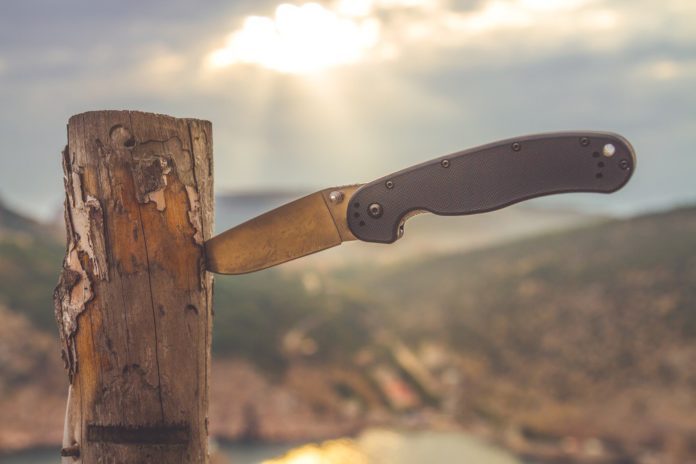What’s the best knife for self-defense purposes? The evidence points to – not using a knife for self-defense in the first place. The legal ramifications for drawing a knife in a self-defense situation are tenuous at best even in knife-friendly locales. The combination of luck and skill required to successfully use a knife as a self-defense tool is daunting. The likelihood of injuring yourself versus who is attacking you must also be considered. Did we also mention that a knife that’s good as a self-defense tool is typically dramatically impractical for day to day tasks?
So, with all that common sense stuff, why bother creating a list of self-defense knives in the first place? Two reasons. One, it’s better to be prepared for something that won’t happen than being surprised by something that does – and something is better than nothing. Two, some of these knives are cool. It’s OK to like cool things because they’re cool. You’re among friends here.
SPYDERCO MATRIARCH 2
The Spyderco Matriarch is an offshoot of the larger Spyderco Civilian, which is probably the most ironically named product since the Ford Aspire, as there is nothing civil about it at all. According to Spyderco, the Civilian was a result of a request from “A government agency” for a knife to be used in last-ditch situations as a defensive tool for people not trained in knife fighting or close-quarters combat in general. So it’s the closest a knife gets to a being an idiot-proof self-defense tool, being designed to be used in a forward-facing “claw” motion.
The Matriarch is the same concept as the Civilian, but scaled-down and sharing its bones with the Endura 4 to lower costs and weight, and it also offers the advantage of an available Emerson Wave opener. For those not familiar, it works in the tip-up carry position – a hook cut into the spine of the blade catches on the edge of your pocket as you draw the knife, pulling the blade open and into the locked position as soon as it’s free of your pocket.
Like the Civilian, the Matriarch has a unique blade shape – a reverse “S” shape with a dramatic recurve to the belly, and a sharp downward-pointed tip. The grind is a very stout low saber grind for strength, and the whole length of the blade is serrated. An “EDC” knife is not – even according to Spyderco, who says “Because of its distinctly specialized features it is not intended or designed for general utility or everyday use.” We appreciate honesty.
FOX KNIVES FOLDING KARAMBIT
The Karambit is a knife style designed expressly for fighting and generally regarded as one of the best knives for self-defense. It has almost no useful value as a day to day cutting tool. Opening your boxes from Amazon or bags of dog food with a Karambit is harder than using your finger. But it is a devastatingly effective self-defense tool, provided you know how to use it properly. There are a number of brands that make folding Karambit knives besides Fox, including Brous Blades, Emerson, Medford, Boker, Bastinelli, Spyderco/Byrd, QTRMSTR, Cold Steel and others – but the Fox Folding Karambit from Italy is probably the most well-known and purpose-designed among them.
If you want a basic guide to defensive Karambit use, this video by Blade HQ does a good job of explaining how to utilize this unique knife. There are a number of identifying characteristics to a Karambit. The “chapter ring” on the end of the handle is one, and the steep hawkbill profile to the blade (an inward curve) is another. The chapter ring serves two purposes – it allows you to pass your finger through it when you draw the knife from your pocket making retrieval easier, and it also serves as a means of securing the knife in your hand when the karambit is held in a reverse (“ice pick”) grip as it’s intended.
Once deployed, a Karambit’s primary purpose is slicing cuts – not jabbing, obviously. The design of the knife favors a reverse grip and allows you to use the blade in a swinging rather than a thrusting motion.
Fox’s Karambits are well regarded among the defense community, and also don’t break the bank like pricier ones from Brous or Emerson. The wave opener gives it the benefit of self-opening when it’s drawn from the pocket, and sturdy G10 scales with a stainless liner lock serve the purpose of a self-defense knife. There’s also an aluminum handled version if you like the feel better.
KA-BAR TDI
The Ka-Bar TDI has been around unchanged for quite a long time because it serves a very specific purpose and doesn’t require constant updates to remain relevant. The TDI is designed as a back-up knife to a handgun, an easy-to-access secondary option if your primary defense tool can’t be reached or doesn’t work. To that end, the TDI is designed around compatibility with gross motor skills rather than fine techniques.
It’s a modified karambit shape – the nearly 90-degree angle of the handle to the blade makes that much obvious – but it’s designed to be used in a forward grip, cross-drawn from a belt holster on your non-dominant side to quickly and effectively cut at close range with a straight wrist. The angle to the handle isn’t a coincidence: it’s designed to be drawn from a holster in a similar manner to a pistol.
It’s an extremely specialized knife design, but it does still hold some day to day practicality that a traditional karambit doesn’t. AUS-8 steel is a reliable choice, black coated here, and contoured polymer handles give you a solid grip with a deep finger choil right behind the bend for control. There’s also a partially serrated variant as well as a large size (3.6”) if you want something bigger.
SPYDERCO P’KAL
The P’Kal is one of the most unique Spyderco’s, and like the Matriarch, it has a decidedly impractical MO. It’s designed around the Filipino martial art of Pikal. Pikal uses a knife held in a reversed ice pick grip to make cuts in a tearing motion using the strength of your upper arm That explains the rather unusual appearance of the P’Kal, which is designed to be held in a reverse grip with the sharpened edge facing in to make pulling cuts. The deep groove along the spine above the lock is actually a finger choil to anchor your hand when you’re clenching it. Once drawn, the P’Kal makes a powerful and agile defense tool as a natural extension of your arm – good for concise, short movements as well as a defense technique for someone attacking you.
The P’Kal uses the caged ball bearing lock, similar to the system in the Manix 2 lineup, as a way to squeeze a strong lock into a small space as well as making the knife easier to close one-handed. It also has a unique implementation of the Emerson Wave opener, a protrusion from the spine of the blade that catches on your pocket on the way out to pull the knife open. On the P’Kal the wave opener is actually a removable post that threads into the spine of the blade. S30V blade steel and textured G10 handles with nested stainless liners should be familiar to Spyderco aficionados.
COLD STEEL URBAN EDGE
Here’s a budget option for those with slim wallets. The Urban Edge is a series of push daggers from Cold Steel that straddle the line between the enormous 4.5” Safe Maker and the minuscule 1” Mini Pal, balancing out usability with portability. At only 1.42 ounces the Urban Edge is light enough to be forgotten, with the sheath designed to be used in a neck knife setup – although a series of rivets on the sheath means it could be adapted to belt carry or just shoved into a pocket since it’s only 4” long total. Blade steel is AUS-8A, in a broad dagger shape with a hollow grind and flat on the back. The handle has a molded rubberized grip. You have three choices for the grind – plain edge, 50/50 serrated (serrated on one side, plain on the other) or fully serrated.
The push dagger is designed to be held in a closed fist, with the blade protruding through your ring and middle fingers away from your knuckles, in a defensive situation for use in a pushing/punching/thrusting motion rather than swung in arcs like the karambit or TDI mentioned above. At only 2.5” it’s not an outrageously large knife, which gives it the benefit of being easy to carry and conceal but it’s long enough to make a difference. A push dagger is even more reliant on gross motor skill than the TDI, and probably less useful for day to day tasks – a real single-use self-defense tool.
EMERSON CQC-13
Ernest Emerson is one of the most well-known names when it comes to tactical knives. He’s been making knives that appeal to “operators” (real and imagined) under the brand of his own name since 1996, and well before that as customs. Emerson is the progenitor and patent holder of the Wave device, a deceptively simple feature that when used correctly will open a knife into the fully locked position as you pull out of your pocket using a small protrusion on the spine.
A knife that opens itself is about as tactical as it gets, and his innovation has spread to many other brands including a broad collaboration with Kershaw. But if you want the most tactical of Emersons, it has to be a Bowie, doesn’t it? The combination of Ernie’s expertise in all things tactical and the traditional fighting-knife shape of a Bowie makes for one intimidating piece of equipment. It’s got all the things that make an Emerson an Emerson, of course: black G10 scales, normal fasteners (the pivot screw is a flathead! Imagine that!), the thumb “disc” opener, and a chisel ground blade in 154CM with a unique dual-textured finish: satin on the grinds, stonewashed flats. At 3.85” it’s on the large side giving you extra reach, and like all Emersons, it has excellent ergonomics. The ZT Emerson collaborations are now discontinued but are worth an honorable mention.
CRKT TECPATL
How cool is the Tecpatl? Aside from its function as a self-defense tool, it’s a neat knife to look at. The Tecpatl is part of CRKT’s Forged by War series, knives, and tools designed by military veterans with 10% of proceeds going to charities of the designer’s choice. In the case of the Tecpatl, it’s designed by Michael Rodriguez, an Army vet with proceeds going to the Special Operations Care Fund and the George W Bush Institute.
It’s a unique knife to be sure, a push dagger with two-finger guards – one complete, one partial – that are designed to be clenched in your fist facing outwards. The blade shape is a modified Wharncliffe, with a full-length swedge that switches over to a sort of reverse-tanto shape towards the tip, while the belly has a long continuous curve up to the tip. This is all designed to give the Tecpatl strong piercing abilities while retaining enough material behind the tip to give it strength to penetrate without breaking off. The steel is SK5 high-carbon non-stainless steel, so a black powder coat is applied to prevent corrosion. This is the canvas for the unique “Sugar Skull” (Calavera) markings and a host of other Easter eggs. The Kydex sheath is Molle compatible too.
AL MAR SERE 2000
The SERE 2000 was the brainchild of the late Al Mar and Nick Rowe in the 1980s as a knife designed for use in the Army SERE training course – Survival, Evasion, Resistance, Escape – which prepares soldiers for unexpected occurrences in the field. To this goal, the SERE 2000 was designed to be a knife that can be relied on in any situation to do what’s needed. It’s not a complicated knife, but it is a tough one – arguably one of the strongest tactical folders around.
A 3.6” (or a 3” on the Mini-SERE) VG-10 blade has a spear point shape with a pronounced swedge and opens with dual thumb studs. A beefy liner lock and flow-through construction make this knife simple, reliable, and easy to disassemble and clean. The handles flare out at the hilt to help keep your hand from slipping forward in rough situations, as do the textured G-10 handle scales. A deep carry clip mounted to the butt of the handle helps keep a low profile. The SERE 2000 series is available in a variety of configurations: satin finish or black ceramic coated blades, and black, digicam or olive drab handle scales. Solid self-defense option.
MICROTECH COMBAT TROODON
It can be argued that part of self-defense is mental over physical, and a giant powerful OTF knife popping open is the blade equivalent of the unmistakable sound of a 12-gauge pump shotgun being racked. Microtech’s are impractical, expensive, overly ornate, needlessly aggressive knives – that will scare the &!#% out of anyone with bad intentions who picked the wrong guy. Theoretically, anyway.
The Combat Troodon is Microtech’s biggest, baddest OTF. It features a dual-action slider on the spine of the handle that both deploys and retracts the blade under spring pressure. Blade steel is Bohler Elmax powdered stainless as standard, although there are a staggering array of variations available: six-blade shapes, serrations or no, three different hardware sets, seven finishes, and fifteen colors – including the fairly offensive Zombie Splatter. Aluminum handles keep it light, and a glass breaker on the butt of the handle also serves as the anchor point for the pocket clip – as well as a makeshift kubotan if you’re so inclined.
CHRIS REEVE PROFESSIONAL SOLDIER
Most people are familiar with Chris Reeve Knives for the iconic Sebenza folder – maybe the newer Inkosi or Umnumzaan folders too. But a lot of people aren’t even aware that CRK makes fixed blades. The Professional Soldier is designed by Bill Harsey (yeah, that Bill Harsey!) in collaboration with the professionalsoldiers.com forum for the Special Forces. It’s a minimalist fixed blade made of – what else? – CPM S35VN stainless steel, PVD coated black as well as some in flat dark earth, with your choice of three blade shapes: a traditional drop point, a modified tanto, or the Inkosi – CRK’s take on a modified Wharncliffe.
Designed to be a versatile carry, the Professional Soldier comes with a Kydex sheath that’s Molle compatible and has some hidden features you wouldn’t notice at first glance. The void in the handle is actually a shackle key to loosen shackle bolts up to 5/8”, and the paracord that’s threaded through the two holes in the rear of the handle has been carefully placed so the knife doesn’t make noise when it’s set down.
It’s arguable that above all else a good self-defense tool doesn’t make itself difficult to carry or use, and that’s what earns the Professional Soldier a spot on this list. It’s slim, simple, easy to carry and conceal, and it has the kind of basic but correct ergonomics you need in an emergency situation. Also, CRK’s build quality is second to none and the Professional Soldier can be reliably passed on to your grandkid’s children assuming it isn’t lost.
BONUS: Medford Marauder
No, not to cut things or slash things. The Medford Marauder, ringing in at around $800 retail, weighs over 11 ounces. The blade is more than a quarter-inch thick. Cut things? Why bother? Just throw it at your attacker – overhand, like a baseball. Knock them clean out, steal their wallet and buy a real knife.





















